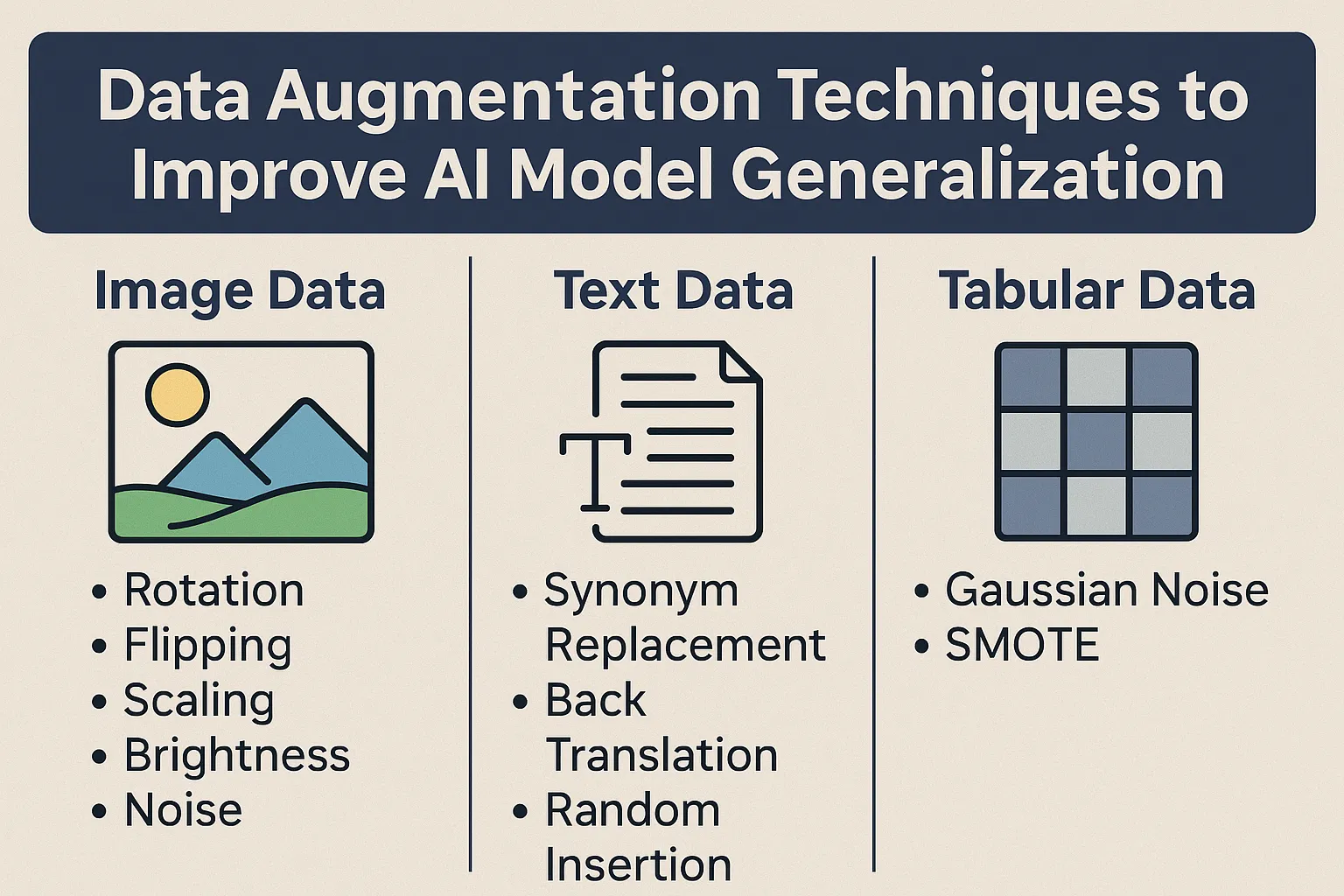
Data augmentation is one of the most effective and accessible ways to improve AI model performance. By creatively modifying existing training data, developers can teach models to generalize better, handle real-world variability, and perform well on unseen examples. When used properly, augmentation transforms limited or imbalanced datasets into rich, diverse learning resources — without needing to collect more real data.
In this guide, we’ll explore the major augmentation techniques used in computer vision, natural language processing, and tabular modeling, complete with explanations, examples, and practical insights for building stronger, more resilient AI systems.
Why Data Augmentation Matters
In machine learning, overfitting happens when a model performs well on training data but fails on new inputs. This usually occurs because the model memorizes patterns instead of understanding them. Data augmentation helps break this habit by simulating realistic variations in data — much like teaching a student to recognize a concept from different perspectives rather than rote repetition.
Key benefits include:
- Reducing overfitting: Models exposed to varied examples become less likely to memorize specific features and more likely to learn general patterns.
- Improving generalization: By training on multiple forms of the same data, models adapt better to unpredictable, real-world inputs.
- Compensating for small datasets: In scenarios where gathering data is costly (medical imaging, rare languages, proprietary datasets), augmentation helps level the playing field.
Image Data Augmentation Techniques
In computer vision, data augmentation is often the difference between a model that recognizes only perfect lab samples and one that performs reliably in the wild. Techniques like rotation, scaling, and brightness adjustments help mimic real-world variability such as different lighting, orientations, and camera distances.
1. Rotation
Rotation changes the orientation of an image by a few degrees in any direction. This teaches the model that the object’s class remains the same no matter how it appears in a frame. For example, a medical model that detects tumors should recognize them even if the scan is slightly rotated.
from tensorflow.keras.preprocessing.image import ImageDataGenerator
datagen = ImageDataGenerator(rotation_range=30)
When to use: Works best for datasets where orientation doesn’t affect the label — such as detecting animals, vehicles, or objects. However, it should be used cautiously in cases like handwriting recognition, where orientation changes meaning.
2. Flipping
Flipping generates mirrored versions of the same image, horizontally or vertically. It’s especially useful for symmetrical objects or scenes where left-right direction doesn’t matter — for example, recognizing a car or dog facing either way.
datagen = ImageDataGenerator(horizontal_flip=True, vertical_flip=True)
Example: In sports analytics, flipping football player images horizontally helps the model detect the same motion patterns on both sides of the field. But for text recognition or traffic sign detection, flipping could distort labels (e.g., turning “STOP” into mirrored nonsense).
3. Scaling and Zooming
Zooming mimics varying camera distances by cropping or enlarging parts of the image. This teaches the model to recognize an object regardless of how close or far it appears.
datagen = ImageDataGenerator(zoom_range=0.2)
Practical insight: Scaling is especially valuable for drone imagery, satellite mapping, and autonomous vehicles, where objects constantly vary in size and distance. However, excessive zooming can crop out essential details and confuse the model.
4. Brightness Adjustment
Brightness augmentation modifies the lighting conditions of an image. Real-world data often contains photos taken at different times of day or under different illumination — adjusting brightness ensures that models remain robust in these scenarios.
datagen = ImageDataGenerator(brightness_range=[0.5, 1.5])
Use case: For facial recognition or medical imaging, brightness variation can drastically change how features appear. Training under multiple lighting levels ensures the model focuses on structure, not color tone or exposure.
5. Adding Noise
Noise injection introduces random pixel variations, simulating imperfections caused by camera sensors or environmental factors. It helps models handle low-quality images gracefully.
import numpy as np
def add_noise(image):
noise = np.random.normal(0, 25, image.shape)
return np.clip(image + noise, 0, 255).astype(np.uint8)
In practice: This is crucial for real-world surveillance or low-light applications, where noise is unavoidable. It trains the model to identify the underlying pattern rather than pixel-perfect accuracy.
Text Data Augmentation Techniques
Text augmentation is key in NLP, where even small datasets must capture the complexity of human language. The challenge lies in diversifying text while preserving meaning. Below are some proven approaches to make language models more adaptable and semantically aware.
1. Synonym Replacement
Replacing words with synonyms expands the vocabulary your model encounters. For example, turning “happy” into “joyful” or “content” exposes the model to different ways the same sentiment is expressed.
from nltk.corpus import wordnet
def replace_synonyms(text):
words = text.split()
new_text = []
for word in words:
synonyms = wordnet.synsets(word)
new_text.append(synonyms[0].lemmas()[0].name() if synonyms else word)
return ' '.join(new_text)
When it shines: Sentiment analysis, spam detection, and chatbot training benefit greatly from synonym diversity. However, context awareness is critical — replacing “bank” in “river bank” with “financial institution” would break meaning.
2. Back Translation
Back translation involves translating a sentence into another language and then back to the original. This process naturally paraphrases text, producing new versions that preserve meaning but alter phrasing.
from deep_translator import GoogleTranslator
def back_translate(text, lang="fr"):
translated = GoogleTranslator(source='auto', target=lang).translate(text)
return GoogleTranslator(source=lang, target='auto').translate(translated)
Example: “The weather is great today” → “The climate is wonderful this afternoon.” This helps models generalize across linguistic variations. It’s widely used in question-answering systems and machine translation datasets.
3. Random Insertion and Deletion
Adding or removing random words forces models to understand context rather than memorizing fixed sequences. It encourages flexibility and robustness in NLP models.
import random
def random_delete(text, p=0.1):
words = text.split()
return ' '.join([word for word in words if random.random() > p])
Tip: Use this technique moderately. While it adds variation, excessive deletion can distort grammar and semantics, reducing text quality. It’s best combined with other methods like synonym replacement or back translation.
Tabular Data Augmentation Techniques
For structured datasets (spreadsheets, sensor readings, financial data), augmentation improves model stability and performance — particularly when classes are unbalanced or noise-sensitive. The goal is to simulate realistic variations without altering data integrity.
1. Adding Gaussian Noise
Gaussian noise introduces slight randomness into numerical columns, imitating natural measurement fluctuations. This keeps models from overfitting to precise numeric patterns.
import numpy as np
def add_noise(df, column, noise_level=0.05):
df[column] += np.random.normal(0, noise_level, df[column].shape)
return df
Example: In financial forecasting, sensor calibration, or temperature readings, no two measurements are perfectly identical. Adding subtle noise helps the model focus on relationships rather than precision.
2. Synthetic Data Generation with SMOTE
SMOTE (Synthetic Minority Over-sampling Technique) generates new, synthetic examples for underrepresented classes. It helps fix class imbalance — a common issue in fraud detection, healthcare diagnostics, and credit scoring.
from imblearn.over_sampling import SMOTE
smote = SMOTE()
X_resampled, y_resampled = smote.fit_resample(X, y)
How it works: SMOTE doesn’t just duplicate data; it creates synthetic samples along the line between existing minority class points. This gives models a smoother, more continuous feature space to learn from, improving fairness and accuracy.
Comparison of Data Augmentation Techniques
| Technique | Best For | Complexity | Key Benefit |
|---|---|---|---|
| Image Rotation | Object recognition and classification | Low | Improves orientation robustness |
| Back Translation | Text classification, NLP tasks | Medium | Creates natural linguistic diversity |
| SMOTE | Imbalanced tabular datasets | High | Generates synthetic minority samples |
Best Practices for Data Augmentation
- Preserve meaning: Always ensure that augmentations don’t alter the true label of the data.
- Mix techniques thoughtfully: Combining moderate transformations often works better than relying on a single aggressive one.
- Use validation data wisely: Keep augmented data only in training sets to measure genuine generalization improvements.
- Monitor edge cases: Some augmentations can unintentionally introduce bias or unrealistic scenarios.
FAQs
Does data augmentation always improve model performance?
Usually, yes — but only when augmentations reflect realistic variations. Random or excessive transformations can make the data less representative and reduce accuracy.
Should I augment validation or test data?
No. Validation and test data should remain untouched to fairly assess how well your model generalizes to real, unseen inputs.
Is data augmentation a replacement for collecting more data?
It’s a powerful supplement but not a substitute. Augmentation enhances what you already have; it can’t create entirely new types of information.
Can augmentation help small models too?
Absolutely. Even lightweight models benefit from exposure to varied samples — it helps them learn broader decision boundaries without increasing parameter count.
Conclusion
Data augmentation is the unsung hero of modern AI — a simple yet transformative practice that can dramatically increase a model’s robustness. Whether you’re training an image classifier, a sentiment analyzer, or a fraud detection model, augmentation teaches it to adapt, not just memorize.
The best AI models don’t just learn from data — they learn from diversity.



